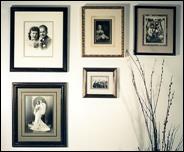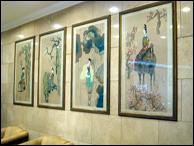 Diagram 1
Diagram 1
Unity in mat, frame size & color.
Hanging a series of 9-up, or rows of 4-6-8 or 10 pieces of matched moulding and mats will have an inherent unity, even when border proportions all vary to accommodate the images. This has been a very popular display arrangement for B&W photos for decades (diagram 1). But unity may not always be established by using the same moulding or mat colors, it may be art by the same artist or subject matter, like postcards, sports memorabilia, or family photos.
 Diagram 1
Diagram 1
Unity in mat, frame size & color.
Wall groupings are a very popular in home décor. Family heirlooms and keepsakes are often framed over the years creating wonderful collages of periods, colors, textures and styles...a lifetime in pictures. Designing to a given room, period and color scheme can be a luxury. And even the best designed series can still fall apart if the space, proportion, balance, and focal point are lacking for the necessary unity to make a group work.
Space and Emphasis
Space is the area between, above and below the individual frames and items in a group. Frames should be placed far enough apart to make an individual visual statement, yet close enough to be part of the group. Too much space between images loses visual unity, but when there is a large wall or cathedral ceiling wider spacing is allowed. The general rule is the tighter the wall space, the closer the placement. It's even popular to butt like size frames tightly against one another in a mosaic pattern create a patchwork pattern (diagram 2).
 Diagram 2
Diagram 2
Patchwork butted grouping.
Focal emphasis—or placement—is important when arranging any group. Designers and galleries are frequently combine furniture settings with framed art to help create mood. The five piece family portrait wall is well balanced by the dried branch arrangement lower right sitting on the table in front of it (photo 1). The placement of frames directly relates to the visual emphasis within that presentation.
 Photo 1
Photo 1
Frames are wider because of large blank, white wall.
Balance
Balance—symmetry or asymmetry—of a grouping, creates the feeling of equal weight and visual attention. The visual center of the group in photo 2 is just left of the trombone. The literal physical center balance point is the right outer edge of the smallest certificate frame. Asymmetrically balanced, the double opening letter/photo frame—to the right—is offset by the three certificates to the left. Though the trombone remains the visual focus, the decorative frame designs do well to hold their own in the group.
 Photo 2
Photo 2
Visual center and balance point is just left of the trombone.
Traditional Placement
Formal groupings require symmetry in hanging. Strict horizontal, vertical or diagonal placement of like framed pieces may be the easiest way to achieve balanced symmetry with a group (photo 3). The four large silk paintings are identically framed and placed 4" apart to fill the large marble wall in this commercial building. By hanging them all evenly horizontal from a common topline—a little above eye level—a natural balance occurs. Though the subject matter varies, the medium and design remain consistent, creating a perfect unified presentation.
 Photo 3
Photo 3
Traditional horizontal placement.
END
Copyright © 2012 Chris A Paschke
For more articles on mounting basics look under the mounting section in Articles by Subject.
Additional information on all types of mounting is found in:
The Mounting and Laminating Handbook, Second Edition, 2002,
The Mounting And Laminating Handbook, Third Edition, 2008 and
Creative Mounting, Wrapping, And Laminating, 2000 will teach you everything you need to know about getting the most from your dry mount equipment and materials as an innovative frame designer.
All books are available from Designs Ink Publishing through this website.
Chris A Paschke, CPF GCF
Designs Ink
Designs Ink Publishing
785 Tucker Road, Suite G-183
Tehachapi, CA 93561
P 661-821-2188
chris@designsinkart.com